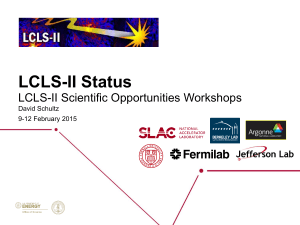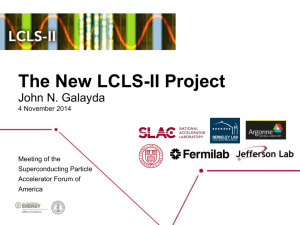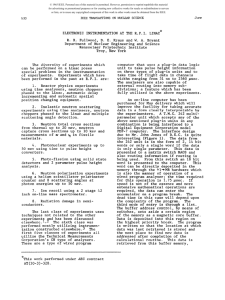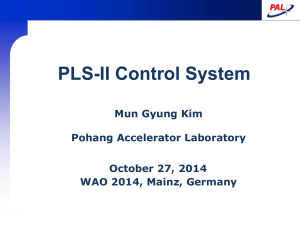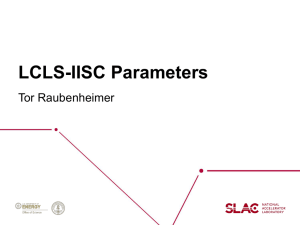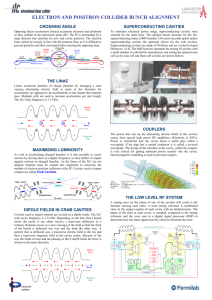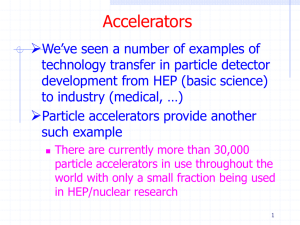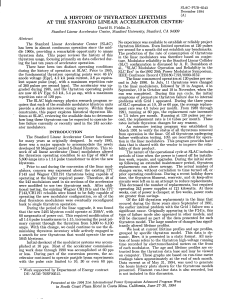LCLS-II R & D Plans Plenary presentation
advertisement
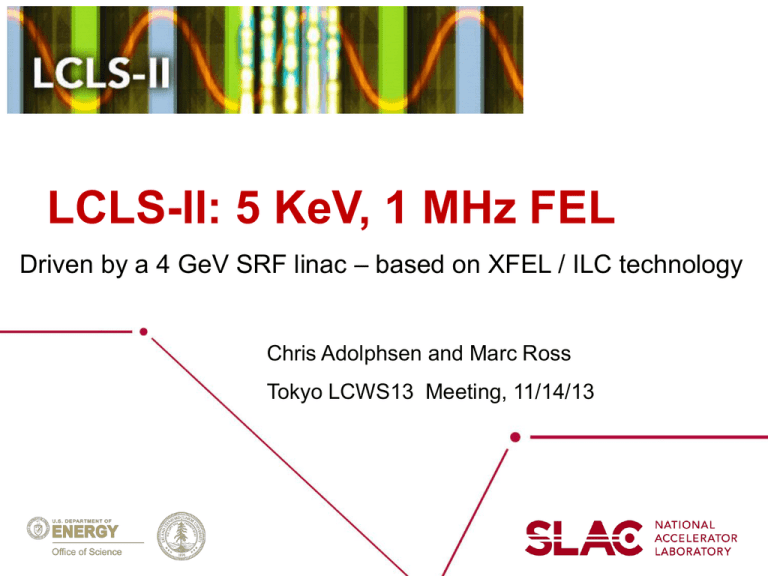
LCLS-II: 5 KeV, 1 MHz FEL Driven by a 4 GeV SRF linac – based on XFEL / ILC technology Chris Adolphsen and Marc Ross Tokyo LCWS13 Meeting, 11/14/13 High-Level Parameters Basic Energy Sciences Advisory Committee (BESAC) report: “… It is considered essential that the new light source have the pulse characteristics and high repetition rate necessary to carry out a broad range of coherent “pump-probe” experiments, in addition to a sufficiently broad photon energy range (at least ~0.2 keV to ~5.0 keV) and pulse energy necessary to carry out novel “diffract before destroy” structural determination experiments important to a myriad of molecular systems. …” Goals: 0.2 – 5 keV photon range with high rate (10 kHz ~ MHz) beam 1.0 – 20 keV photon range with LCLS-similar performance LCLS-II Planning Meeting, Oct 9-11, 2013 2 SLAC’s proposed answer to BESAC challenge: Current Baseline • 4 GeV CW Superconducting RF Linac - • • • • Based on XFEL / ILC 1.3 GHz cavities 35, 8-cavity 1.3 GHz cryomodules / 280 cavities 3, 4-cavity 3.9 GHz cryomodules / 12 cavities 16 MV/m Gradient; Qo = 2e10 at 1.8 deg K 0.1 mA typical, 0.3 mA max at 1 MHz bunch rate 25 micron bunch length 1.2 MW Max Beam Power 5.5 MW Cryogenics power LCLS-II Planning Meeting, Oct 9-11, 2013 3 Location of the SLAC SC Linac Replaces First Kilometer of the Normal-Conducting S-band Linac 4 Accelerator Operating Modes • Two sources: high rate SCRF linac and 120 Hz Cu LCLS-I linac • North and South undulators always operate simultaneously in any mode Undulator SC Linac (up to 1 MHz) North 0.25-1.3 keV South 1.0-5.0 keV Cu Linac (up to 120Hz) up to 20 keV higher peak power pulses • Concurrent operation of 1-5 keV and 5-20 keV is not possible 4 GeV, 0.3 mA, 1.2 MW 4 GeV SC Linac SCRF Linac in 1st km of SLAC tunnel LCLS-II Overview Cu Linac 0.2-1.2 keV (120 kW) 1.0 - 20 keV (120 Hz) 1.0 - 5 keV (120 kW) New transport lines designed for <10 GeV beam Existing LCLS transport lines for 17 GeV beam 5 LCLS-II - Linac and Compressor Layout for 4 GeV L0 j=* V0 =97 MV Ipk = 12 A Lb = 2.0 mm HL V0 =220 MV Ipk = 12 A j =-165° Lb =2.0 mm V0 =55 MV CM01 CM2,3 L3 j=0 V0 =1447 MV Ipk = 50 A Lb = 0.56 mm V0 =2409 MV Ipk = 1.0 kA Lb = 0.024 mm CM04 3.9GHz LH GUN L2 j = -21° L1 j =-22° E = 98 MeV 0.75 MeV R56 = -5 mm sd = 0.05 % CM15 CM16 BC1 BC2 E = 250 MeV R56 = -55 mm sd = 1.4 % E = 1600 MeV R56 = -60 mm sd = 0.46 % CM35 LTU E = 4.0 GeV R56 = 0 sd 0.016% 2-km 100-pC machine layout: Oct. 8, 2013; v21 ASTRA run; Bunch length Lb is FWHM Linac Sec. V (MV) j (deg) Acc. Grad. (MV/m) No. Cryo Mod’s No. Avail. Cav’s Spare Cav’s Cavities per Amplifier L0 97 * 14.6 1 8 1 1 L1 220 -21 14.1 2 16 1 1 HL -55 -165 14.5 3 12 1 1 L2 1447 -21 15.5 12 96 6 48 L3 2409 0 15.4 20 160 10 48 * L0 cav. phases: ~(-40, -52, 0, 0, 0, 13, 33), with cav-2 at 20% of other L0 cavity gradients. P. Emma, L. Wang, C. Papadopoulos Includes 2-km RW-wake Cryomodules in SLAC Tunnel SLAC Linac Tunnel (11 feet wide x 10 feet high) (3.35 m x 3.05 m) 7 LCLS-II SCRF development and production: Fermilab Jefferson Lab Cornell ERL Cryomodule Cross-section Showing increased Cooling capacity Argonne Lab Cornell University SLAC These labs will form an SCRF partnership for development, production and testing; supported by DoE Office of Science - BES LCLS-II Planning Meeting, Oct 9-11, 2013 8 Horz Dressed Cavity Test (BCP, 120C, HF rinse) Initial Cooldown 1.6 K 1.8 K 2.0 K 10 11 Quality Factor 11 Quality Factor 10 After 10 K Thermal Cycle 10 10 10 5 10 15 1.6 1.6 1.8 1.8 2.0 2.0 10 20 5 Eacc K Before Cycle K After Cycle K Before Cycle K After Cycle K Before Cycle K After Cycle 10 15 20 Eacc Initial Cooldown at 16.2 MV/m Q(2.0 K) = 2.5 x 1010 Q(1.8 K) = 3.5 x 1010 Q(1.6 K) = 5.0 x 1010 10 K thermal cycle at 16.2 MV/m Q(2.0 K) = 3.5 x 1010 Q(1.8 K) = 6.0 x 1010 Q(1.6 K) = 10.0 x 1010 Georg Hoffstaetter, Cornell University LCLS-II workshop, SLAC 9 10 October 2013 CM Development: High Q_0 cryomodule with reduced cryogenics operating costs: Improved cooling capability New cavity surface processing recipe Improved magnetic shielding Adiabatic cool-down process US FY 2014 CDR Q_0 recipe CM testing CM Prod. First X-rays 2015 2016 2017 2018 2019 Separate liquid management in each cryomodule but no external transfer line 650 MHz Cryomodule Design, 21 Feb 2011 11 Peterson, FNAL-SLAC Meeting Sept 10, 2013 Page 11 CW TESLA Cavity Testing at HBZ* Load at 17 MV/m is 19 W, well below measured 35 W flux limit * Rev Sci Instrum. 81, 074701 (2010) Modifications to 2 K Pipes to Accommodate Larger Heat Flow • Slightly larger nozzle from helium vessel to 2-phase pipe • Slightly larger 2-phase pipe • • Increase from 55 mm to about 70 mm Depends on string lengths and liquid management plan Retain option for 1.8 K in all piping Increase from 72 mm to about 90 mm Segmentation of 2 K liquid and 2 K flow distances may also impact this pipe sizing The cryomodule itself will be the most likely source of fast (< 1 sec) pressure changes, so attention to piping and valve configurations are critical Peterson, FNAL-SLAC Meeting Sept 10, 2013 Antenna Modifications for E-XFEL “The feedthroughs are made of high conductivity materials, pure niobium, molybdenum and sapphire. They will be connected thermally to the 2-phase tube with copper braids for better heat transfer to the 2 K environment.” J. Sekutowicz RF Power, QL and Overhead Parameter Value Comment Gradient 16 MV/m On crest Beam Current 0.3 mA Cavity QL 4.12 e7 Based on formula on next slide – minimizes power for 10 Hz microphonics (MP) offset Max Power per Cavity ( w MP w/o overhead) 5.72 kW Power with 10 Hz MP offset – no overhead Max Power per Cavity (w MP w overhead) 6.32 kW Assume 94% transmission and 4% overhead Max Power for 48 cavities (w MP and w overhead) 303 kW Either one source per cavity so can track MP locally or one source for 48 cavities RMS MP offset allowed with a 300 kW source 9 Hz For Gaussian distributed MP Inner Conductor Temperature Distribution with Different Thicknesses of Copper Coating for 15 kW CW RF Power 10µm on outer conductor with RRR=10 Shilun Pei CM Gradient (Vector Sum) Stabilization at DESY Goal: Stability of the vector sum for the cw operation with the new µTCA LLRF. Conditions: Eacc = 3.5 MV/m, mode cw, piezo feedback off, bias on. QL = 1.5e7 Test Result: 1s Vector sum phase phase RF-feedback on Standard deviations for: Amplitude = 6.2 E-5 Phase = 0.0098° Vector sum RF-feedback off Standard deviations for: Amplitude = 1.5E-3 Phase = 0.5° 1s Conclusion: New µTCA RF-feedback improves amplitude and phase stability by factor of 24 and 51 respectively, and fulfills spec for the XFEL linac. W.- D. Möller, J. Sekutowicz| CW Operation of XFEL Modules| June 14, 2013| Page 17 JLAB Upgrade Cavity Microphonics • • Determines the Feedback Gain needed for control. Effects are driven by QL and the available klystron power for lightly loaded cavities • Minor change to the tuner pivot plate substantially improved the microphonics for the CEBAF C100 Cryomodules. Microphonic Detuning* C100-1 C100-4 RMS (Hz) 2.985 1.524 6s(Hz) 17.91 9.14 Cavity C100-1-5 • While both meet the overall system requirements the improved design has a larger RF power margin Cavity C100-4-5 TTC Workshop June 2013, T. Powers, JLAB MICROPHONICS COMPENSATION AT HZB w/o control feedback Detuning (Hz) Detuning (Hz) SFFT feedback & feed-forward compensation Time (s) Frequency (Hz) Reduced detuning by an order of magnitude # events Achieved „open loop“ phase stability:13.2° 2.0° 0.02° phase stability achievable sf = 2.52 Hz sf = 0.89 Hz sf = 0.36 Hz Compensate multiple resonances Needs implementation into LLRF control and operation with beam Detuning (Hz) Axel Neumann 19 ‘BESSY’ Microphonics Example 41 Hz mode driven randomly to yield a 1.5 Hz rms frequency variation – then solve cavity field level with a constant rf input and beam current Resulting Energy Variation over Time: 9e-4 variation in a cavity energy gain, which if uncorrelated cavity to cavity, would produce 7e-5 beam energy variation at the end of the linac (ignoring the BCs and the various FB systems) Claudio Rivetta Bruker 10 kW CW Source Consists of eight 1.25 kW water-cooled modules - each module has eight 160 W, isolated transistor units that are summed in a coaxial combiner – the output of the each module drives a common WR650 waveguide – no solenoid, HV PS, filament PS nor vacuum pump Newer units with higher power transistors produce 16 kW in one rack Two 10 kW units at HZDR and a 5 kW unit at Cornell Waveguide Run between Gallery and Tunnel (Also considering 3” coax with ~ 2% additional loss) Isolator 27 in diameter, 15 feet long penetrations spaced by 6 m Toshiba E37750 300 kW CW Klystron (Need 5 Units plus Spare) Beam Voltage 49.5 kV Beam Current 9.8 A Output Power 305 kW Input Power 34 W for sat. Perveance 0.89 uP Efficiency 63.2 % Gain 39.5 dB Thompson 540 kVA, 55 kV PS for NSLS II (PSM - summed switching supplies – claim 95 % eff) Need 5 Units plus spare – maybe cluster so rotate role of spare 12 kV AC In 50 kV Out NGLS 4 CM Waveguide Layout (6*l_rf cavity spacing) 1 of 2 klystron outputs phase shifter H-plane T Isolator w/ pickups custom H-plane bend L2=5.5 lg custom E-plane T flex guide custom E-plane bend L1=1.5 lg SC Linac Milestones (version 03.10.2013) SC Linac Preliminary Design Review CM Pre-production Start SC Linac Final Design Review Begin SC Linac Procure / Fab Start CM Production (Start D & D SLAC Linac 0-10) Begin SC Linac Installation Cryomodule Production Complete Complete SC Linac Installation Complete Checkout & no-beam Comm Complete Checkout & beam Comm FIRST LIGHT 03.2014 10.2014 12.2014 03.2015 04.2015 04.2016 10.2016 10.2018 02.2019 03.2019 05.2019 09.2019 Production: 48 months 2 yr start + 2 CM / 3 months Installation: 28 months 2 CM / 3 months
